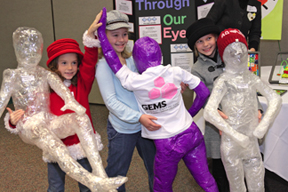Hailey Dill is an 8-year-old third grader at West Jasper Elementary, and she has an answer to the question adults always love to ask children: What do you want to be when you grow up?
 |
| Clanton Intermediate School third graders Madison Price (left), Anna Smith (center) and Allie Lightsey show transparent, opaque and transluscent dolls they made out of packing tape. |
Math and science are important subjects for Dill if becoming a dentist is her dream. A recent event hosted by the UAB School of Education gave girls as young as Dill the opportunity to create and exhibit math and science experiments and demonstrate their ability to use technology such as digital cameras, podcasts and other multimedia tools.
Girls Engaged in Math and Science (GEMS) brought together more than 100 girls and their teachers for a special math and science fair earlier this month. The premise behind GEMS is to generate excitement in learning math and science among girls – and hopefully to inspire them to consider professions that require deep knowledge in those fields.
“My background is in math and science, and I’ve always had a love for math and science,” says Melanie Shores, Ph.D., associate professor of education and the principal investigator of the GEMS grant, a $341,000 award from The Malone Family Foundation.
“If I can do it, I want other girls to know they can do it. I have a daughter of my own, and I want her to know she can do it, too. She can be a doctor or a scientist.
“She can be whatever she wants to be.”
Gaining knowledge, confidence
Leigh Evans is trying to instill that belief in her young female students. Evans, a two-time UAB graduate, is a third-grade science teacher at West Jasper Elementary, where 86 percent of students receive free or reduced lunch. Her classroom of 20 students includes only six girls, all of whom participated in creating an edible animal cell as part of their project.
The girls made Jell-O, which was representative of the cytoplasm. Whoppers served as the nucleus and hot tamales represented the mitochondria.
“We examined how those parts are related to the parts of our bodies,” Evans says. “We talked about how the nucleus is like our brain and the mitochondria is like our stomach and gives us energy and processes food. They made a project board and a photo story, and they had a great time. They have really taken their study guides and prepared.”
West Jasper Principal Eric Smith had two fifth-grade classes that also participated in the GEMS exhibition. One group focused on the value of the coral reef.
The other group chose the rain forest. He saw the excitement level in his students first hand when they presented their projects to him before the exhibition. Two things about their presentation impressed him — the depth of knowledge the girls attained and the confidence with which they presented their projects.
“Some of the girls are very smart, but they didn’t always show a whole lot of confidence in their abilities,” Smith says.
“But they presented their project to me with poise and self-assurance. At the expo, when people came up to see their project the girls smiled, presented their project to them and told them how they did it. I was very impressed. I’m extremely proud of them.”
Another group of third graders awed some of the older girls with their ideas for showing the difference in translucency, transparency and opaqueness.
Tammy Price’s Clanton Intermediate class created life-size dolls from packing tape. The clear doll represented transparency, the white doll translucency and the purple doll opaqueness. The girls also created translucent stained glass and opaque artwork.
“I don’t think they will ever forget the definition of those scientific terms after today,” Price says. “The girls came up with some really creative ideas, and the next day they came up with another. It took off from there.”
Real-world application
All of the projects on display at the exhibition were created based on GEMS lesson plans that were developed this past summer in workshops hosted by the School of Education.
Education professors worked with Alabama teachers to develop lessons that use methods proven to boost girls’ confidence in math and science classes and incorporate 21st century technology skills.
The lessons that the workshop participants created now are posted online on the Alabama Learning Exchange (ALEX) Web site at http://alex.state.al.us/tc_tf_results.php. ALEX was created by the state Department of Education and is a resource for teachers worldwide seeking lesson plans and ideas for teaching various subjects.
“These teachers selected a lesson plan on ALEX, taught it and then guided these students in creating projects,” Shores says.
“It’s essentially an extension of a lesson plan. The students had to ask and come up with an answer to the question, ‘How can you use this in the real world?’”
Shores hopes the School of Education will be able to make GEMS available to area schools again next year.
“We’re applying for money now,” she says. “This has been so successful and just a fantastic opportunity for these teachers and students. We hope to continue doing these types of things with funding.”